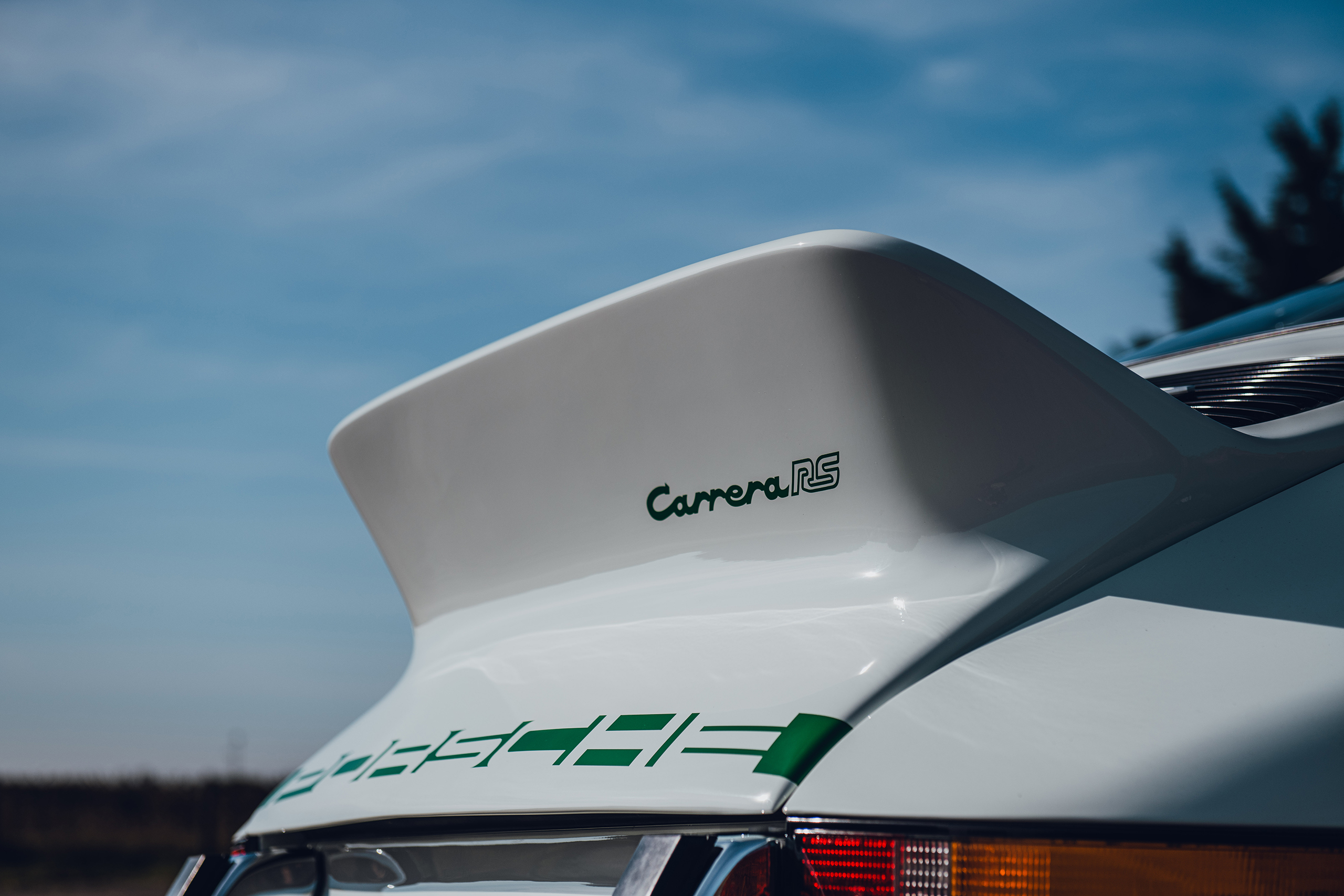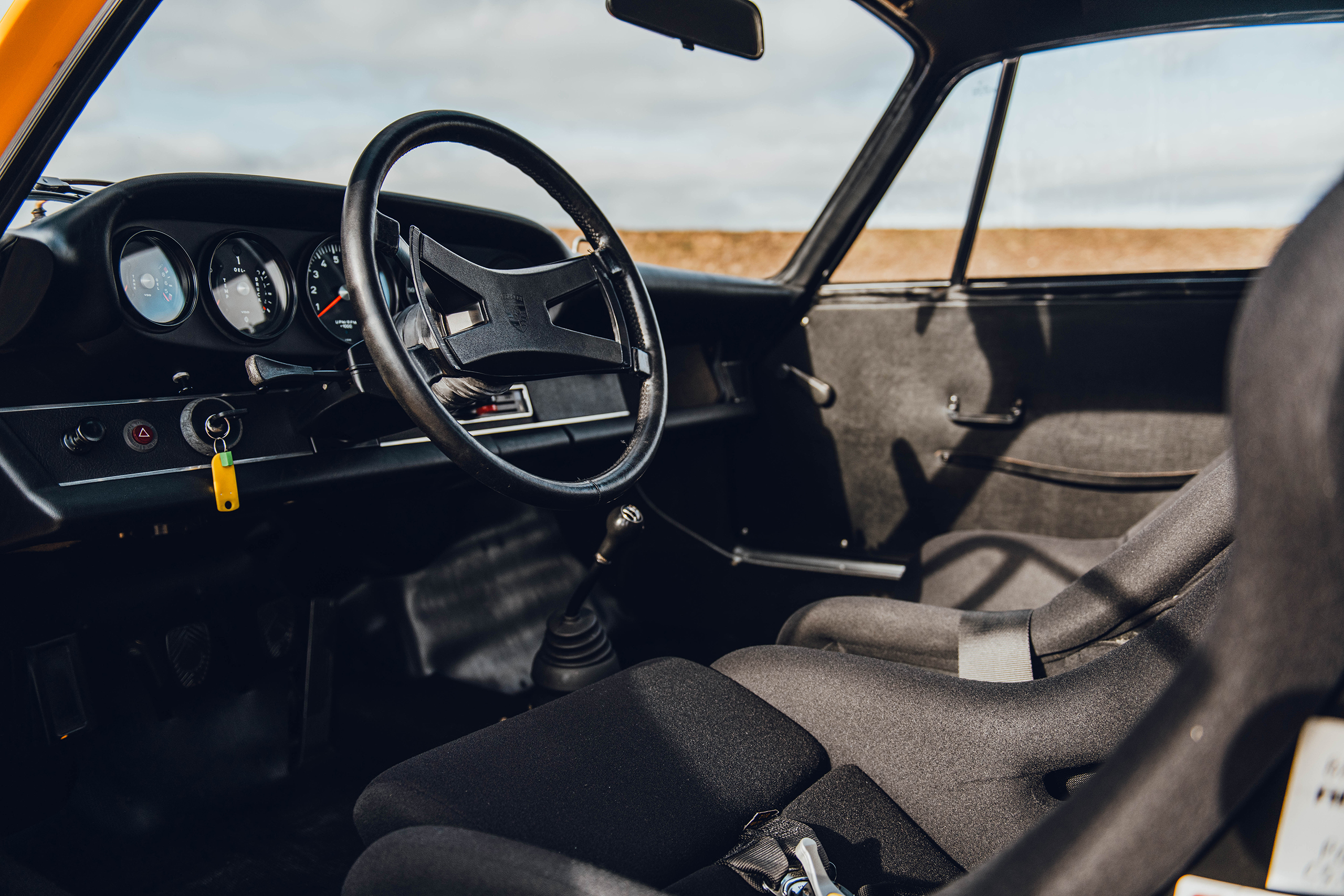In 1971, Helmuth Bott, the head of Porsche’s vehicle development, convened his team in his office after the question arose as to why their customers could not compete with the BMW 2002s and the powerful Ford Capris on track. This issue was attributed to the sloping rear end of the Porsche 911, which acted as an airplane wing. As a result, the front end became lighter, providing little stability in fast corners. Efforts were made to find a solution aimed at minimizing the front lift of the Porsche 911. Allow me to tell you the tale of the duck and the whale.
Helmuth Bott’s team included Hermann Burst, Tilmann Brodbeck who had just graduated in aircraft technology and aerodynamics from the Technical University of Darmstadt and stylist Rolf Wiener. Brodbeck, who at the time owned a Fiat 850 Coupé 2+2 that he was fond of, as he mentioned in an interview with ‘Hagerty,’ exchanged it for a series II that came with a 5 hp performance increase and a little flick on the end of the engine cover. “I was astonished, it felt a lot faster, I knew it wasn’t possible with just 5bhp, so I asked the people at the Darmstadt wind tunnel if it could be the new engine cover – but they said it was just styling, nobody knew at the time,”. This experience prompted the development of the ‘ductail’ .
Who would have thought that finding a solution to a problem would give rise to an icon? Helmuth Bott, Hermann Burst, Tilmann Brodbeck, and Rolf Wiener had no idea. Various versions of a spoiler were crafted from sheet metal and wooden blocks to provide more stability to the Porsche 911. Initially, there was laughter about the design, which resembled the tail of a duck. However, Günter Steckhöning, an experienced racer, demonstrated the effectiveness of this spoiler: he achieved higher speeds and reported improved stability. With each iteration of the spoiler, the height was increased, resulting in an increase in speed and reduced air resistance for each iteration, until this gain in speed and resistance leveled off. Ultimately, an increase of 4.5 km/h was observed. To comply with safety standards for other road users, the tail was shortened to stay within the body lines of the car.

1972 Porsche 911 Carrera RS 2.7
Porsche was eager to emphasize the connection between street usage and race cars and introduced the Porsche 911 Carrera RS 2.7 (RS for Rennsport) at the Paris Motorshow in October 1972, which would feature these improved aerodynamic components designed for the then-current 911 models. “We wanted to improve traction and handling with wide tyres on the rear axle because the greatest weight is found on the rear axle” Peter Falk explains on the official website of Porsche. For this, the development engineers took inspiration from Porsche racing cars. Fuchs, who made the wheels, forged 6 J×15 wheels with 185/70 VR-15 tyres at the front, with 7 J×15 with 215/60 VR-15 tyres at the rear. To accommodate them, the car’s body at the rear, around the wheel arches, was widened by 42 mm. This was combined with a firmer-tuned, lighter suspension system and thicker anti-roll bars, lightweight aluminum front beams, reinforced control arms, and cross-member reinforcement at the back.
The Porsche 911 Carrera RS featured enlarged bores, increasing from 84mm to 90mm, resulting in a displacement of 2687cc. It maintained the same valves and compression as the 2.4, allowing the engine to unleash 207hp to the rear wheels at 6300 RPM. In addition to aerodynamic and engine modifications, Porsche also focused on weight reduction. Thinner sheet metal, reduced glass thickness, and the removal of sound insulation were implemented. The interior of the 911 Carrera RS 2.7 ‘Lightweight’ (M471) was stripped down to the bare essentials. Elements such as the rear seat, carpets, clock, coat hooks, and armrests were omitted. At the customer’s request, lightweight bucket seats replaced the heavier sport seats. Even the Porsche emblem on the hood was glued on. The eventual weight of the lightweight version was approximately 960kg. The marketing and sales staff doubted the concept of a fully stripped lightweight Porsche 911, pointing to the extremely limited production of the Porsche 911R in 1967, with only 20 units leaving the factory. Alongside the initial lightweight (M471) variant, which saw the production of 200 units, a more comfortable version was introduced – the Touring (M472). Certain components that were removed from the 911S for weight reduction were reintroduced in this Touring conversion, resulting in a final weight of 1093kg. The first batch of the Touring comprised 300 units.
The Porsche 911 Carrera RS 2.7 marked the very first Porsche to wear the name ‘Carrera’. The inspiration for the name was drawn from the Carrera Panamericana, a legendary (and highly perilous) Mexican road race that traversed from border to border in the early 1950s. In 1953, Porsche secured a memorable class victory with a Porsche 550 Spyder, followed by a third-place finish overall the year after. Subsequently, various powerful Porsche engines were already assigned with the ‘Carrera’ name. When a name was needed for the new top-tier 911, the newly designed lightweight Porsche stood out. ‘Carrera’ it read between the wheel arches on both sides in a color contrasting with the body paint, intersected by a broad stripe in the same color. This color scheme extended to the Carrera RS sticker on the ducktail and the Fuchs wheels, as well a thin line surrounding the car, for the lightweight conversion.
In order to qualify for participation in the Group 4 category for GTs and special touring cars, the Féderation Internationale de l’Automobile (FIA) imposed a minimum production of 500 identical cars, each weighing less than 1000kg. However, the Touring variant exceeded this maximum weight, necessitating a solution from Porsche. Yet, at Porsche, they demonstrated cleverness, great cleverness: every Carrera RS underwent a complete strip-down and was taken to an official weigh station in Stuttgart, where the scale registered 935kg before being reassembled to the desired specifications. In the end, a total of 1580 Carrera RSs were produced: 200 Lightweights, the first batch of 300 Tourings with thinner sheet metal followed by 1008 later Tourings, 17 RSHs (H for Homologation), representing fully stripped units that were never reassembled to Lightweight- or Touring and received the ‘0’ conversion code. Additionally, there were 55 RSRs (RSR for Rennsport Rennen).
The Porsche 911 Carrera RS 2.7 established itself as the fastest German production car at the time.
1973 Porsche 911 Carrera RSR 2.8
In 1973, 55 RSH body shells were taken off the assembly line and transported to Werk 1, Porsche’s Racing Shop. The RSR was assigned the M491 code and underwent significant changes. They incorporated every conceivable improvement allowed by the FIA rulebook.

On the exterior, the most striking features of the RSR included the extremely wide fenders, accommodating the exceptionally wide tires and Fuchs wheels (9J x 15 at the front and 11J x 15 at the rear). The front spoiler featured an opening for the oil cooler, giving the RSR an aggressive look. Inside, the interior was further stripped down compared to the M471 conversion, which was already lightweight in itself. Porsche managed to save an additional 80 kg: a rubber mat covered the metal floor, leather straps served as door handles, minimal interior trim, and a half roll cage completed the interior. Notably, the interior boasted an extremely cool tachometer with a redline at 10,000 rpm.
The engine was enlarged to 2800cc by increasing the bore to 92mm, featuring larger valves, twin-plug ignition, and an increased compression ratio of 10.3:1. The six-cylinder engine (type 911/72) produced 300 hp at 8,000 rpm and maximum torque at 6,300 rpm. Suspension refinements and the 917-based braking system significantly enhanced handling and driving characteristics. Meanwhile, the RSR’s chassis was reinforced at three key points at the rear of the car to meet the demands of high-speed racing.

Surprisingly, the car clinched victory in its inaugural race, the 24 Hours of Daytona, straight out of the gate. Due to its non-homologation in Group 4, it had to compete in the prototype category, Group 5. The Brumos-entered car, driven by Gregg and Haywood, was the first to cross the checkered flag. Another Brumos entry two weeks later secured the overall win at the 12 Hours of Sebring, with once again Peter Gregg, Hurley Haywood, and Dr. Dave Helmick. Following Daytona, the Martini-sponsored factory cars claimed victories at Dijon and the grueling Targa Florio.
A new 3.0 engine and new aerodynamic features such as the ‘Mary Stuart’ tail and larger wheel arches that adorned the RSR allowed Porsche to set the fastest time at Le Mans testing, but finished fourth in the subsequent 24-hour race. These aerodynamic features were carried over to the Nürburgring, where Van Lennep and Müller finished in fifth place. Towards the end of the season, the factory experimented with the long-tail configuration, as seen in Zeltweg and Watkins Glen (now adorned in the Brumos and Sunoco liveries)..
1974 Porsche 911 Carrera RS 3.0
Porsche had considered discontinuing the 911 in 1974. However, they ultimately reconfigured their successful sports car to comply with the requirements of the crucial American market, which had introduced the 5 mph bumper impact regulation. Porsche also implemented some modifications to their lightweight Carrera RS model, resulting in the RS 3.0. By producing 100 units of this car, Porsche successfully homologated the RS 3.0 as an “evolution” of the RS 2.7/RSR 2.8.

Among these changes, the most significant include an enlarged, horizontal rear spoiler as an derivation of the ‘ductail’, wider wheels and tires, a cast aluminum crankcase, and slightly altered inner pivot points for the rear suspension. The broader wheels and tires necessitated wider fenders, which, for racing purposes, could be extended laterally by an additional 5 cm each to accommodate 11-inch-wide front and 14-inch-wide rear wheels. Upon delivery, the car features 8-inch forged aluminum rims at the front and similar 9-inch ones at the rear, shod with 215/60VR-15 and 235/60VR-15 Pirelli CN36 tires for both front and rear. Particularly intriguing is the fact that the cars were delivered with two types of the ‘whaletail’ spoilers. The smaller one, equipped with rubber protection, was intended for road use. This spoiler was deemed pedestrian-friendly and thus had to stay within the overall length of the car. For racing purposes, there was the larger spoiler with an additional opening for cooling.

Assuming that most of these RS 3.0’s would be purchased by people intending to race them, presumably with Group 4 modifications, as races for Group 3 cars are virtually nonexistent. Therefore, they decided to offer as many race-specific specifications as possible as standard: the car comes equipped with the cast crankcase, 95 mm Nikasil-plated aluminum cylinders, a large oil cooler for racing, a transmission oil cooler with the necessary pump built into the rear cover of the gearbox, and the immensely expensive drilled disc brakes developed for the 917 Can-Am turbocharged car!
Built upon a completely standars 911 body, the RS 3.0 featured integrated bumpers and front/rear lids out of plastic. The door panels are crafted from lightweight gauge-steel to maintain a low overall weight, and sound insulation is kept to a minimum for the same purpose. Thinner glass is selected for the side and rear windows to achieve additional weight savings. Additional weight reduction measures include a significantly simplified interior lining, the elimination of rear seats and other interior components and the substitution of standard seats with plastic bucket seats. The RS 3.0 is slightly heavier than the RS 2.7 and that’s not strange when you consider that the wheels and tires are heavier, and there are two oil coolers with their plumbing. Additionally, the aluminum crankcase weighs about 22 pounds more than the magnesium one of the standard 911 models. Overall the 911 Carrera RS 3.0 was heavier than the RS 2.7 but rest assured: it was just as fast! The five-speed gearbox was adopted from the 2.7 street cars, including a limited-slip differential as part of the package. The suspension was similar to that of the RSR models from late 1973, with a few detail changes, and the brakes were directly sourced from the 1973 RSR.
1974 Porsche 911 Carrera RSR 3.0
Porsche produced a total of 109 cars, with 55 built as Carrera RS for road usage and 54 as RSR models for racing purposes. As an evolution of the RSR from 1973, the 1974 RSR shared the same philosophy: it was a more aggressively prepared, further-stripped, race-ready version of its sibling, the Porsche 911 Carrera RS featuring a new 3.0-engine as tested at Le Mans in 1973. This resulted in one of the most successful Group 4 race cars of its time. While the RSR 3.0 was initially campaigned by the factory team, its real success came from being purchased and raced in large numbers by customer teams.

At the end of 1971, the mighty and quite possibly the most impressive race car ever, the Porsche 917, was banned from the circuit (except for the Turbocharged Flat-12 Can-Am cars that raced until 1974). Consequently, there were many spare parts and Porsche utilized the braking system and center-lock wheels from the Porsche 917. The even wider tires than those of the RS3.0 were accommodated in broader wheel arches equipped with an air intake that served as cooling for the brakes.
To save weight, fiberglass was used in the bumpers, hood, front lid, and the ‘Whaletail.’ Lightweight Perspex windows replaced the glass in the side windows for additional weight savings, and the interior was stripped down to the essentials. Porsche managed to bring the weight down to approximately 900 kg.

In addition to weight savings, particular attention was given to the flat-6 engine (911/75): it boasted a larger bore and a robust aluminum crankcase, replacing the magnesium one of the standard 911, to withstand the increased forces. The Type 911/75 flat-6 engine featured twin-plug ignition, high-lift camshafts, Bosch twin-spark fuel injection, a compression ratio of 10:3.1, dual megaphone exhausts, a dry sump oil tank, and retained the same 5-speed transmission as the RS. Generating 330 bhp at 8000 rpm and a torque of 232 ft lbs at 6,500 rpm, the substantial power increase was noteworthy. However, the more significant advantage for racing lay in the substantial improvement of reliability brought about by these modifications. The drivetrain was finalized with a reinforced clutch and a five-speed gearbox.

In 1974, the Porsche works team shifted its focus to the development and racing of a turbocharged variant of the 911, eventually giving rise to the 934 and 935 models. Consequently, the responsibility of campaigning the newly introduced Carrera RSR 3.0 now rested solely with privateers. Porsche continued the production of the RSR 3.0 through 1974 and into 1975, supplying these vehicles to customer racing teams.During this period, privateers experienced a unique advantage with a car that demonstrably outpaced their competitors. Frequently, multiple RSRs would contend for race victories, while other brands posed a challenge only as trailing contenders.

Johan-Franck Dirickx, whose love for lightweight Porsches began when his grandfather acquired a vibrant yellow 911 RS 2.7, currently possesses one of the largest 911 collections worldwide. This collection includes the RS/RSR models as featured in this story. In 2021 Johan invited me to spend some time with the RS 2.7, RSR 2.8 and RS 3.0 at Abbeville, missing out on the RSR 3.0. This year, I was invited once again by Johan to Abbeville, where we placed the RS 3.0 and RSR 3.0 side by side and turned the final page of the tale of the duck and whale.
Thanks, Johan, for sharing this experience!
























